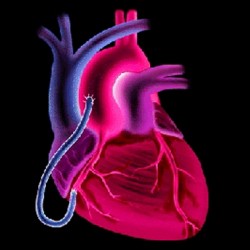 Improving the treatment of heart disease
Improving the treatment of heart disease
Circulatory disease is and has been the leading killer worldwide for the past century (WHO). Available treatments for heart failure were developed 30-40 years ago to treat blood pressure. “There’s clearly a need for new approaches,” says Stuart Cook (Molecular Cardiology Group). In collaboration with scientists from the USA, Austria, France and the UK, he has won a prestigious Leducq award to research the mechanisms underlying dilated cardiomyopathy, a common cause of heart failure.
The condition affects around 1 in 2000 people worldwide and results in an enlarged heart that cannot pump blood effectively around the body. “We know dilated cardiomyopathy is genetically regulated,” reveals Stuart, “and we have people in this new scientific network that work on disease models in flies, fish, rodents and humans. So we’re looking across the board to find new ways to diagnose and treat the disorder.”
So what are the genetic factors? Mutations in patients can occur in genes, whose protein products make up the basic muscle contraction units in the heart. Examples include Titin (TTN), the largest gene in the body and genes that make the proteins actin and myosin. As Stuart notes, “we know that there are many mutations in Titin, but it’s often difficult to say what’s causative or not,” also these structural genes aren’t necessarily drug targets.
To identify potential drug targets, the plan of action is to have a discovery phase in humans. “We’ve hundreds of human DNA samples from which we can identify specific disease genes.” The scientists will use model organisms to learn about where those genes sit hierarchically in the context of gene networks and metabolic pathways within cells, as these are highly conserved across species. “We can really dig into the mechanisms using model organisms,” Stuart confirms.
Mutations in sarcomeric genes, like Titin, don’t themselves drive disease, so there’s probably no point in trying to target them. “We need to find out what’s downstream of those mutations.” Individuals with similar mutations in Titin may have different disease phenotype, which is why the scientists really need to understand the genetic context, how Titin gets regulated in health and disease. “Different drugs might be suited to different underlying genetic backgrounds,” adds Stuart.
Rats and mice, like humans, have spontaneous mutations in Titin that are associated with heart failure. And the gene can be completely knocked out in some animal models. Knockouts in fish develop a cardiomyopathy, although they manage to compensate by absorbing oxygen from the water around them. In flies an RNAi-based approach, which allows researchers to easily switch off genes, has helped researchers identify ‘cardiomyopathic’ mutations. All in all, a huge wealth of data exist to explore.
Once potential targets are uncovered, the scientific network will test potential drug molecules using high-throughput cell-based in vitro assays. “And next-generation sequencing technology means we can now move faster than ever towards new therapies,” says Stuart. The biggest cause of heart failure is heart attack, after which heart muscle dies. “By screening people early and having a range of potential therapeutic avenues, we stand a much better chance of improving the treatment of this disease.”
BM
The Genomic, Epigenomic and Systems Dissection of Mechanisms Underlying Dilated Cardiomyopathy, a Fondation leducq funded programme commencing January 2012 (www.fondationleducq.org) combing the expertise of leading transatlantic researchers with a $6 million dollar award for five years. Josef Penninger (IMBA, Austria); Phillip Charron and Francois Cambien (INSERM, France) Tim Aitman (Physiological Genomics and Medicine); (Christine and Johnathan Seidman (Harvard, USA); Callum MacRea (Harvard, USA); Andrew Marks (Columbia university, USA).
